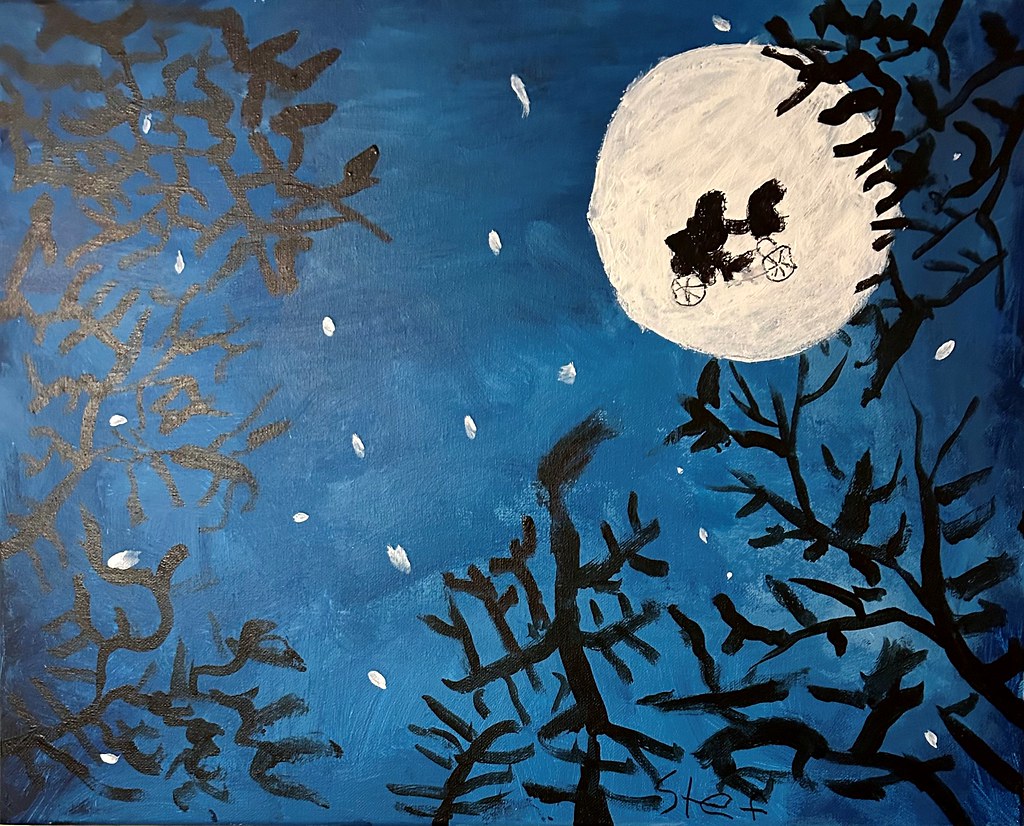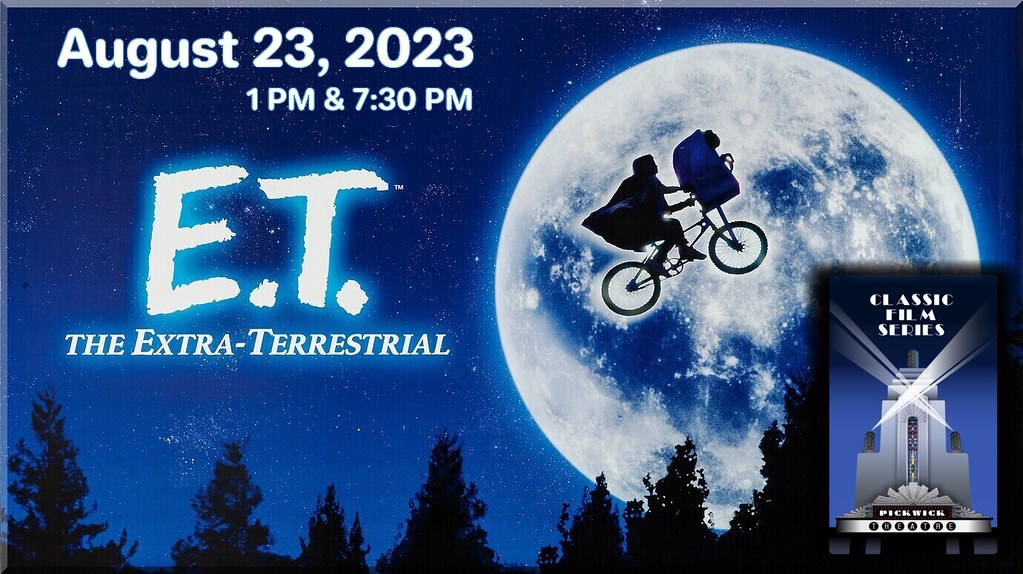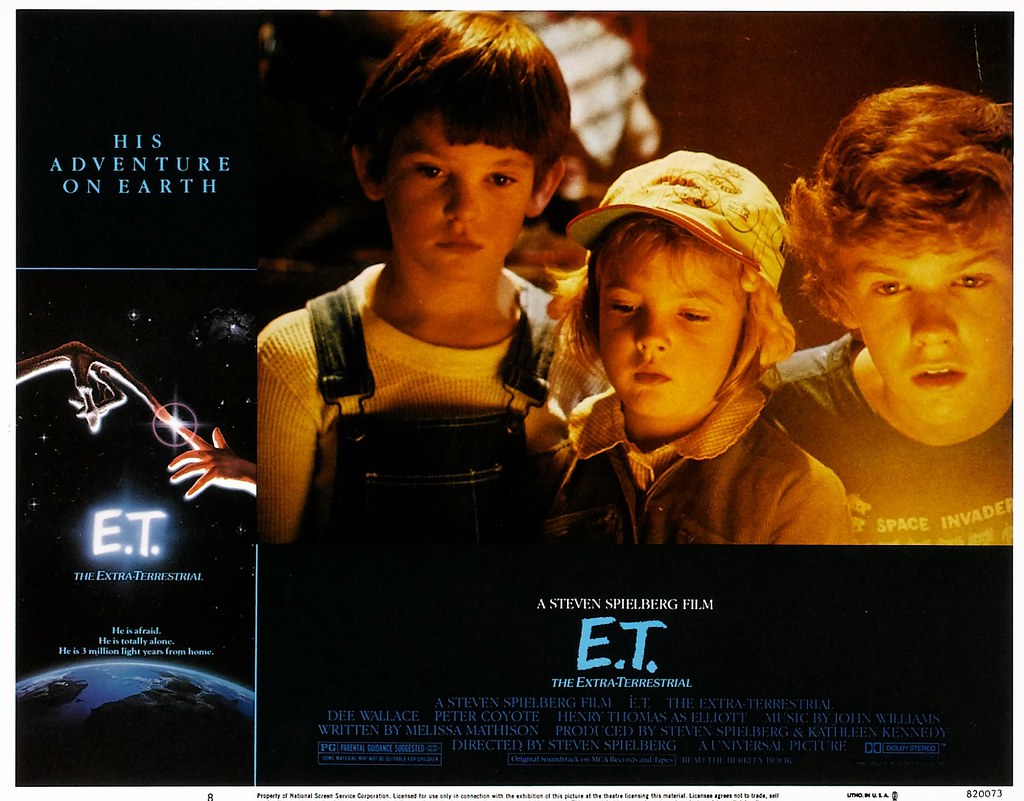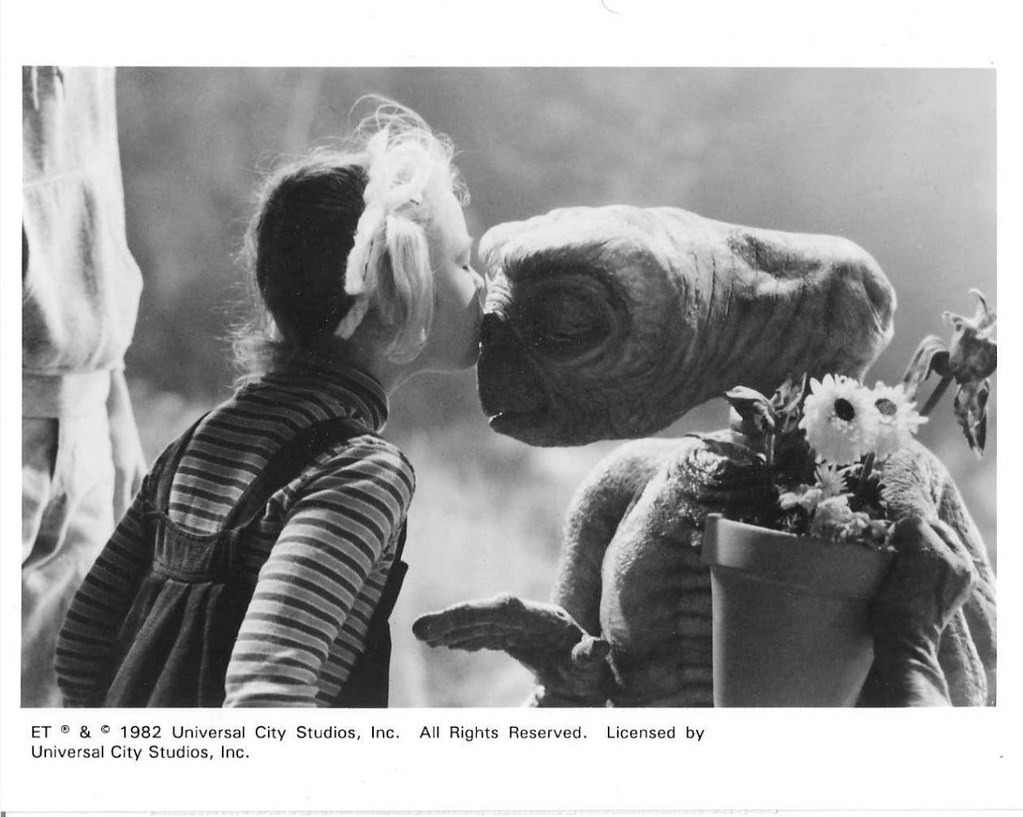WHAT: E.T. The Extra-Terrestrial (1982, DCP)
WHEN: August 23, 2023 1 PM & 7:30 PM
WHERE: Pickwick Theatre, Park Ridge, IL
WHAT ELSE: Organist Jay Warren performs pre-show music at 7 PM!
HOW MUCH: $12/$10 advance or $10 for the 1 PM matinee
Advance Tickets: Click Here!
“This movie made my heart glad. It is filled with innocence, hope, and good cheer. It is also wickedly funny and exciting as hell. ‘E.T. The Extra-Terrestrial’ is a movie like ‘The Wizard of Oz,’ that you can grow up with and grow old with, and it won’t let you down. It tells a story about friendship and love. Some people are a little baffled when they hear it described: It’s about a relationship between a little boy and a creature from outer space that becomes his best friend. That makes it sound like a cross between ‘The Thing’ and ‘National Velvet.’ It works as science fiction, it’s sometimes as scary as a monster movie, and at the end, when the lights go up, there’s not a dry eye in the house.” ~ film critic Roger Ebert
Any child of the 1980s will remember E.T. The Extra-Terrestrial (1982). It was a film that became a cultural phenomenon. “E.T. Phone Home” was a catchphrase that was everywhere. I was the same age as Drew Barrymore in 1982, and I vividly recall seeing the film once in a theatre. Afterward, I remember for Halloween that year I wore my E.T.-themed costume– probably one of the worst-looking costumes I ever wore. It was one of those plastic, Collegeville products that had a rubber-band mask of E.T. with a picture of him on my chest. (I never should’ve left the house in that.)
Over the years, E.T. has been embraced as one of the great American films, and certainly one of director Steven Spielberg’s most cherished. It essentially established all the themes that would mark him as a family-oriented filmmaker. E.T. recently celebrated its 40th anniversary, and although we are a year late, we are not too late to present it on our Mega-screen on August 23, 2023. This is a special end-of-summer/back to school event.
The origins of E.T. go back to Steven Spielberg’s own childhood when he invented an imaginary friend to help him cope with his parents’ divorce in 1960. That sense of loneliness and isolation from family returned when he was in Tunisia shooting Raiders of the Lost Ark (1981). It was then that he decided he wanted to tell this more intimate story that, although not taken directly from his own life, encapsulated many of the insecurities and fears of childhood. As Spielberg himself has said, the story was about a “disenfranchised and lonely boy.”
Steven Spielberg was no stranger to stories about space creatures, having already made Close Encounters of the Third Kind (1977). Writer and director John Sayles originally submitted to Spielberg a draft of a screenplay called Night Skies, which was a darker, more violent story about aliens on Earth. Although the Sayles script was not used, a subplot in the material, which dealt with a friendly alien and an autistic boy, helped point Spielberg in the direction he wanted to go. Screenwriter and associate producer Melissa Mathison wrote the first draft, titled E.T. and Me. (A 1988 “rip-off” movie would be called Mac and Me.) Spielberg and Mathison’s story would go through a couple more rewrites before it became the story we know as E.T.
During a visit to Earth to gather flora specimens, an alien life form, E.T., is separated from his mother ship. He is pursued by a group of men who are tracking the UFO. Left behind, E.T. is able to escape to the suburbs down in the San Fernando Valley. Meanwhile, Elliott, a ten-year-old boy living with his two siblings and mother, is trying to find a place in the world around him. His parents are separated and he doesn’t quite fit in with the other boys in the neighborhood. While outside, he discovers E.T. Unbeknownst to the mother, the creature is brought into the household and introduced to such marvels as television and junk food. He is soon revealed to Elliot’s older brother, Michael, and their younger sister, Gertie. Elliott and E.T. have a symbiotic relationship in which Elliott is able to feel what E.T. is experiencing. The family eventually tries to help E.T. contact home, but their lives are interrupted by outside forces. The hunters, led by a man identified by his “keys,” finds the family at a time when both Elliott and E.T. are deathly ill.
Henry Thomas was chosen to play Elliott, the boy who befriends E.T. Thomas made his character authentic and true to how a real-life child might act. Top-billed Dee Wallace played the mother and the only grown-up who is actually seen in the first half of the movie. Robert MacNaughton was cast as the older brother, Michael. Drew Barrymore, the granddaughter of acting legend John Barrymore, portrayed Gertie, the youngest sibling. Cast in the role of “Keys,” the government agent who tracks E.T. down, was Peter Coyote. Since the majority of the principal roles would be played by kids, Steven Spielberg decided to shoot the film in rough chronological order; the idea being that the children would respond as actors in a more spontaneous manner as they watched the story unfold before them.
Behind E.T. were many actors, puppeteers, special effects people and voices. But the design of the animatronic creature was done by Italian special effects artist Carlo Rambaldi, who had previously designed the aliens for Spielberg’s Close Encounters of the Third Kind. One of E.T.’s most distinct features, his wizened eyes, were partly inspired by such famous people as Albert Einstein, Ernest Hemingway, and Carl Sandburg. E.T. was voiced primarily by Pat Welsh, although it was modified electronically by sound designer Ben Burtt.
With a budget of $10.5 million, production began on September 8, 1981. The film would be completed in 61 days. By his own standards, this was a smaller, more intimate film for Spielberg, who would be working with only one alien in the story. Interestingly, Spielberg shot the adults in a manner that obscured their faces. This was supposedly inspired by the cartoons of Tex Avery. When the child actors weren’t working, they attended school on-set between scenes. There was little time for play, although Spielberg went out of his way to make the set as fun as possible. During Halloween, he dressed up as an old lady while filming one particular scene. Although Henry Thomas was excited by everything that was in the story, there was one scene he dreaded making; it was the scene in the biology class in which he had to kiss the “pretty girl”– a young Erika Eleniak.
John Williams, Spielberg’s frequent collaborator, composed the Oscar-winning film score. Its main theme has become so famous it’s heard at practically every Academy Awards telecast. His music, whether it’s the bike chase theme or the emotional farewell, is such a part of the film’s success it would be impossible to imagine it with any other score. Williams composed over 80 minutes of music for E.T., including a brief snippet of “Yoda’s Theme” from The Empire Strikes Back (1980). This insertion of one of his earlier motifs is heard when E.T. sees a child wearing a Yoda costume on Halloween.
E.T. was released on June 11, 1982, and immediately became a sensation– a film embraced by both audiences and critics who saw in E.T. a direct link to the family classics of an earlier generation like Peter Pan and The Wizard of Oz. All told, the film would be number one at the box office for 16 weeks, eventually surpassing Star Wars as the highest-grossing film ever at that time. It held the global record until it was surpassed by another Spielberg movie, 1993’s Jurassic Park.
The film featured many Spielbergian themes that would earmark him as a director of family fare. E.T. features kids, their empowerment, and the American suburban setting. In fact, the film put Spielberg on a different trajectory from the adventure films he had been making. He had a personal connection to the story of Elliott, and as a result of this affinity, the film has a deeper emotional level. Spielberg would direct many other kids movies in the years to come, to varying degrees of success, but none have matched E.T. in terms of introspection and mystical beauty.
One of the most famous moments in the film is the scene in which E.T., riding in the front basket, levitates Elliott’s bicycle into the night sky. This sets up the shot of Elliott peddling past a full moon. This has often been cited as one of the most memorable images in cinema history; it’s associated with the film to such a degree that Spielberg used it as the logo of his production company, Amblin Entertainment.
E.T.‘s impact on popular culture was immediate and long-lasting. In terms of merchandising alone, the character of E.T. was everywhere: from t-shirts to lunch boxes to an infamously ill-fated Atari video game. But even the goofiest movie tie-ins have a certain nostalgic charm to them today. E.T. also features one of the most famous product placements in film history: Reese’s Pieces candy! For the film’s 20th anniversary, Spielberg released an ill-advised “enhanced” version that, in some scenes, removed the government men’s guns and replaced them with walkie-talkies! Spielberg would later admit that this was a mistake. The digital enhancements can be found throughout the special edition as well as in some of the film’s deleted scenes. The artificiality of the “CG E.T.“ (which already appears outdated) shows audiences just how remarkable the original animatronic was with its practical, old-school effects.
E.T. is a profound film about understanding, compassion, healing and love. Its themes are universal, and its message has been embraced globally by people of every background. It’s been a “heartlight” in the lives of many. Anyone who has felt like an outsider in the world or suffered through illness would have a special connection to E.T. and to the film itself. One such person who loved this film was my cousin, Stefanie Mary Sullivan, who had special needs and passed away in 2022. E.T. was Stefanie’s favorite film. We are dedicating this screening to her memory.
~MCH
A painting by Stefanie Sullivan. Stefanie overcame significant physical challenges to express herself through art. In her memory, her family initiated the The Stefanie Sullivan Joyful Arts Program. This program is taught by local artists, using acrylics on canvas. Attendees receive individual instruction based on their abilities. It is open to anyone with special needs who loves art. The Joyful Arts Community meets at the Options & Advocacy in Crystal Lake.



